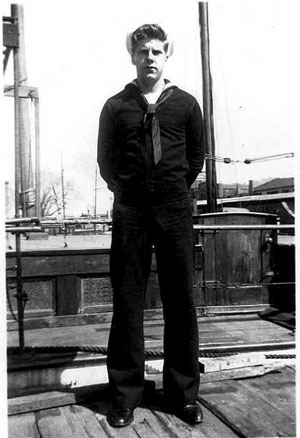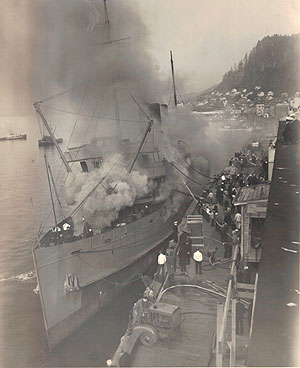 The Burning of the S.S. Prince George One Crewman died when fire destroyed liner at Ketchikan Dock in 1945 By DAVE KIFFER September 20, 2010
The 306-foot, three-stacked steamer, which had been coming to Ketchikan for more than 30 years, was eventually beached on Gravina Island where its burned out hull remained for several years before finally being towed to Seattle and scrapped. 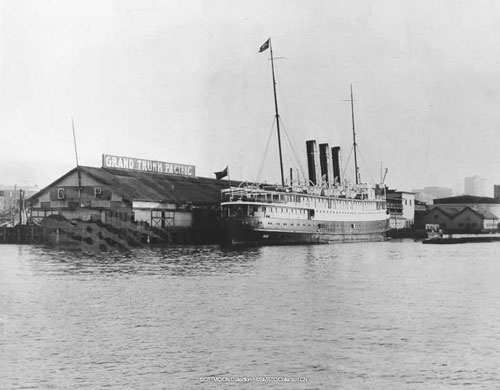 Photo courtesy Bill Hughes
The $500,000 ship had been built at Wallsend-on-Tyne in England in 1910. It was approximately 306 feet long, carried more than 200 passengers and crew and traveled at speeds between 16-18 knots. It had been on the Vancouver to Southeast Alaskan run since the early 1910s, and was part of CN's "luxurious" sailing fleet, although it probably represented luxury sailing circa 1910 more than luxury sailing circa 1945. The Grand Trunk Pacific Railway steamship line had been the brainchild of Charles Hays, the man who "invented" Prince Rupert (see "Prince Rupert: Hays Orphan Looks to the Future" SITNEWS, Feb. 27, 2007) as the terminus of his transcontinental rail line. His planned empire included railroads, steamships and hotels. But Hays died in the sinking of the Titanic in 1912 and his company eventually went bankrupt. Grand Trunk ships began serving the Inside Passage in 1910. In the early 1920s, the Grand Trunk operations were merged with other companies into what was called the Canadian National line. Between World War I and World War II, there were five CN ships plying the coast, the Prince Rupert, the Prince George, the Prince Henry, the Prince David and the Prince Robert. But the war years hurt the luxury touring industry and the princes Henry, David and Robert never returned to passenger service after being converted to war time service in World War II, leaving only the aging Prince Rupert and Prince George on the Southeast Alaska run. Round trips on the steamers took seven days, but they also made shorter occasional runs between the communities. On Sept. 22, 1945, the Prince George docked in Ketchikan on a short-round trip voyage from Prince Rupert to Ketchikan. There were 88 crewmembers on board the vessel and two dozen passengers disembarking in Ketchikan. Approximately two dozen other passengers were scheduled to get on board for the trip back to Prince Rupert and six round trip passengers were to remain on board for the trip back. 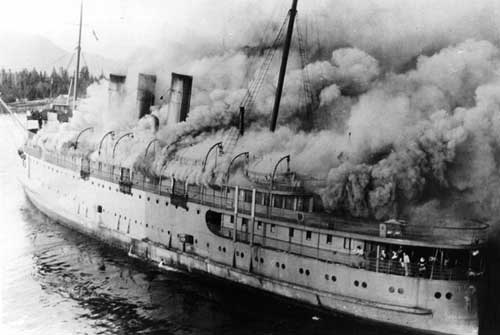 The ship caught fire September 22, 1945. She was towed from the dock and allowed to burn when it became clear that the fire was uncontrollable. Donor: Bert Libe, Courtesy Tongass Historical Society
The ship had docked at 8:10 am and the fire alarm sounded 10 minutes later, according to the Ketchikan Chronicle. "Crews of firemen, Coast Guardsmen and civilians were on the spot, fire hose covered nearly every foot of the dock and chemicals arrived," the Chronicle reported later that afternoon. "For more than an hour scores of firemen used every facility available in a futile attempt to bring the blaze under control but when every effort was expended the ship had to be taken away from the dock. "Expressing the sentiment felt by hundreds of local people, Stewardess Hutchison, fighting to keep the tears back, stood on the dock, 'I never thought I would stand (here) and see her burn. I'm just watching her burn' she said as the battered, smoke blackened ship limped away on her dramatic final sailing," the Chronicle reported.
Ritter responded along with 14 other Coast Guardsmen, he said in a recent interview. Using a Hale pump to bring water up from the Narrows, they helped fight the fire for more than hour. Ritter said he remembers communicating through a ventilator shaft with Prince George crewmen who were fighting the fire below decks and trying to keep the ship's steam pressure up so the bilge pumps would clear the water being poured onto the flames. But after an hour, Ritter said, the hull plates of the ship were glowing red and the vessel was listing significantly. A decision was made to evacuate the ship and the two dozen crew members, Coast Guardsmen and Ketchikan firefighters on board evacuated, some clamoring onto the bow of an ocean going tug that was trying to move the burning ship away from the Ketchikan dock. Ketchikan resident Jim Wingren said that his father Al, was one of the last two firefighters on board the vessel as efforts were made to get the ship away from the dock. "They had been fighting the fire somewhere in the forward portion of the ship when the 'abandon ship' was given," Wingren said recently. "They crawled on their hands and knees to the stern of the ship while flames were shooting out over their heads from the broken out windows. They jumped down onto the bow of the tug that was pushing the George from the pierhe (his father) was the last man off and it was hot!" Three days after the fire, Sept. 25, Ketchikan fire chief W.E. Eastham told Ketchikan Daily Fishing News - the forerunner of the Ketchikan Daily News - that 32 members of the fire department responded to the fire and that the crew had actually managed to extinguish the flames in the engine compartment but that the fire had spread elsewhere at that point. He said the fire department had four houses, three with water and one with foam, fighting the fire. The fire began when there was a "blowback" during the lighting from one of the ship's steam boilers, according to Bill Hughes, who was a 16-year-old "fireman" on board the Prince George. Hughes, who was raised on a remote Hudson's Bay trading post in Canada, had been on the Prince George off and on for nearly two years. He had been a porter, before becoming a fireman in August of 1945. During those years toward the end of World War II, it was not unusual for younger men to work on board the steamships. The Prince George's crew listed several 16 and 17 year old crew members. Hughes said that a fireman's duties primarily involved maintaining the steam pressure and balance in the boilers. 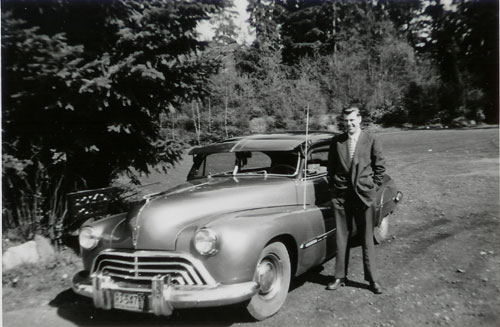 Photograph courtesy Bill Hughes
Hughes had just finished his shift at the boilers and was in his bunk asleep when the fire occurred. A two-man crew, Verdun McDaniel - a 32-year-old Canadian Air Force veteran from Vancouver - and 17-year-old Douglas Marshall were lighting a boiler. Hughes said he knew McDaniel, who had joined the crew two weeks before, pretty well. "He was an engine room day man and had been sent forward to the stokehold to help the Fireman (Marshall)," Hughes said. "He liked to crouch down and watch the fire ignite. In this case, the blowback hit him square in the face. The fireman tried to help (him) instead of fighting the fire, but could not lift him. The fireman finally dragged him to the 'fiddly' ladder but could not lift him to his shoulders to climb the ladder." Crewman Raymond Hurley told the Ketchikan Chronicle on Sept. 22, 1945 that he had been in the galley adjacent to the engine room when the fire started "I heard him (McDaniel) scream after the flashback of oil and I ran up forward and spread the alarm," Raymond Hurley told the Chronicle. Hurley also told the Chronicle that he witnessed Douglas Marshall, the other fireman on duty attempt to move McDaniel to safety before having to flee the fire himself. Marshall and other crew members then tried to get back to McDaniel. An engineer named "Sandy" tried twice to enter the engine room but was overcome by smoke.
"Then one of the cooks who was a buddy of Mac's put on a gas mask and tried to fight his way in but the heat was terrific," Hurley told the Chronicle. Marshall was one of two crewmembers later hospitalized for smoke inhalation, according to the Chronicle. Hughes said the crew was well-trained in on board firefighting and had just had a fire drill two days prior to the fire. Interestingly enough, local fire responders were also "in shape" for a dock fire because a $70,000 fire had destroyed much of the nearby Ketchikan Cold Storage facility just a month earlier. But the September fire spread so quickly there was little to be done to save the Prince George. Hughes also said that for some reason, there wasn't enough pressure or water in the onboard fire hoses. So he manned a hose put on board by either the fire department or the Coast Guard until the abandon ship was sounded. "At the time the US Coast Guard was putting drums of foam fire retardant aboard in drums," he said recently. "By this time, it was too late. Fighting an oil fire with water is the worst thing you can do, however given the year and the war effort foam fire retardant was a recent development and not widely available." The evacuation of the ship went quickly and smoothly, according to passenger Mrs. William Wikstrom. She told Chronicle that she and her cabin mate had noticed that the floor of their cabin seemed unusually warm shortly before the alarm sounded. She and other crew and passengers told the Chronicle that it was a miracle the fire had not occurred at sea. The fire brought out hundreds of residents who watched as smoke plumed through the Downtown and Newtown areas. Then the Canadian tug, General Kennedy began towing the ship away from the dock. First, the tug attempted to beach it on Pennock, but eventually the Prince George was beached on Gravina Island "From North Tongass and north Second Street the burning liner could be seen all night long Saturday by residents, dozens of whom took pictures of her from the outer Newtown district," The Chronicle reported on Monday, Sept, 24. "About 10 pm, Saturday one of the oil tanks on her apparently exploded for flames lighted the sky for miles around." The Chronicle also reported heavy oil covered most of the water in Tongass Narrows, much of it burning. In addition to the General Kennedy, several Coast Guard vessels, including the subchaser Monterrey, the frigates Annapolis and Bangor, the Salvor and the tug Fornance, were involved in fighting the fire and then getting the burning ship away from the dock. 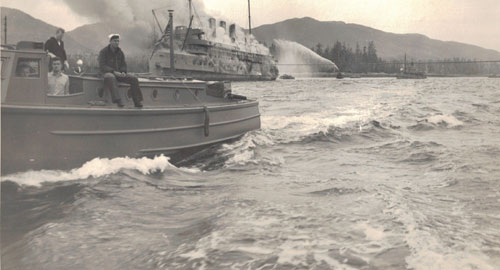 Photo courtesy Ketchikan Fire Department
One of the ironies of the fire was that the tugboat that was involved in towing the Prince George away from the Ketchikan dock, the General Kennedy, had pulled a another burning vessel away from a dock in Vancouver a couple of months earlier. Frank Dwyer, a member of the Kennedy's crew, told the Chronicle on Sept. 24 that the Kennedy pulled the Green Hill Park away from the Canadian Pacific dock in Vancouver after it exploded earlier in the spring. The Chronicle reported that the Kennedy had arrived from Prince Rupert shortly after the Prince George landed in Ketchikan. It was bringing members of a Canadian "ball" team to Ketchikan. "We had just tied up when we heard an explosion," Dwyer told the Chronicle. He said the Kennedy was the first ship to reach the Prince George and helped rescue some of the crew from the ship. He also said that the Kennedy crew used its fire hoses on the Prince George for more than an hour before eventually towing the "torch-like" ship around Pennock Island. "The first time we put her on Pennock Island, but the tide was coming in so fast we had to take her downstream for fear the tide would take her back out," Dwyer told the Chronicle. "It was risky work as she zigzagged down the channel until we could find a satisfactory spot to beach her. About 10 minutes before she was safely beached (on Gravina Island instead) she was a roaring inferno, boilers blew up and the spray hit the deck of our ship." The ship continued to burn for the rest of the weekend, until tides and the collapse of its superstructure eventually flooded the fire out. It wasn't long before local residents tried to get closer to the burned out hulk, necessitating the Coast Guard posting a patrol nearby to prevent onlookers from trying to board the ship, according to the September 24, Ketchikan Chronicle. A party of ship's officers boarded the still smoldering vessel on September 26 and recovered McDaniel's body, according to the Ketchikan Chronicle. On Thursday, the 27th, the 88 crew members of the Prince George left for Vancouver on the Prince Rupert. According to the Chronicle, they had spent their time being housed at the Ketchikan Coast Guard base. There they volunteered for "work details" and helped out in the base galley. They particularly enjoyed spending time with the local Coast Guardsmen. Purser Arthur Robsen lauded the local Coast Guard . "I can't tell you much
we all enjoyed our stay here as guests of the Coast Guard,"
he told the Chronicle on Sept. 26. "The boys are all tickled
and there is not one of us who is not sorry to leave." G.A. Macmillan, superintendent of the line was still in Ketchikan meeting with insurance adjusters on Sept. 27, when he told the Ketchikan Chronicle that he appreciated the "generosity" that the residents of Ketchikan had shown the stranded crew and passengers. He noted that there would be no inquest into the fire because there was no evidence of foul play, although representatives of the US Coast Guard would issue a formal report in the near future. 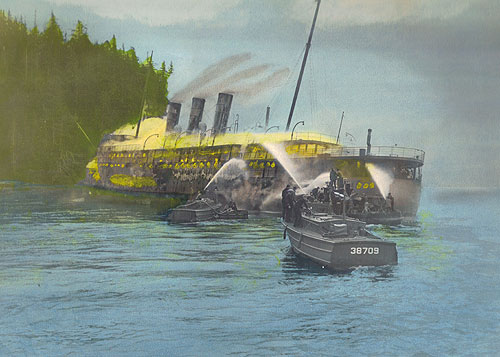 Photo courtesy Ketchikan Fire Departmetn
Macmillan also told the Chronicle that any new ship would probably be a combination vessel that could also carry a significant number of automobiles between Vancouver and Haines, where they could take the Haines cutoff road into the Yukon and northern Alaska. But when the new Prince George came on line in 1948, it was not a combination vessel. It was still primarily a passenger ship although it did have a significant cargo hold. The new Prince George was reportedly the largest commercial vessel built in Canada up to that point. Built by Yarrows Ltd, Esquimalt, BC in 1948, the new Prince George sailed the Alaskan route until 1974. In 1976 it was sold to Wong Bros Enterprises, Nanaimo for conversion to floating restaurant. It went through the hands of several companies over the next 20 years and was even used for floating hotel space for Canadian events such as the Vancouver World's Fair in 1986. It caught fire at the dock at Britannia Beach, BC in October of 1995. It was then sold for scrap. It was being towed to China when it sank in Unimak Pass on Oct. 25, 1996. The charred hulk of the original Canadian National passenger liner Prince George was eventually refloated and towed to Seattle, where it was beached and broken up for scrap. But what year that happened is not clear. H.W. McCurdy's "Marine History of the Pacific Northwest" lists the year the ship was hauled off Gravina as 1949. CN Railway's history of the company steamships lists the year as 1948. Both Wingren and Hughes believe it was 1953 and there was a reference to the steamship "hulk" still being on Gravina Island in a 1951 edition of the Ketchikan Chronicle. Bits and pieces of the Prince George were salvaged by locals and put to new uses. For many years, my family had a door stop made out of a railing from the ship. Hughes and Ritter went on to have other careers, Ritter returned to Baltimore and worked for the Baltimore Gas and Electric Company for many years. He now lives in Hanover, Pennsylvania. Hughes stayed in the transportation industry for several years before moving on into diesel engine repairs and service. He also managed West Coast sales operations for several larger diesel engine firms. He lives in Vancouver, B.C. Sixty-five years later, both still have vivid memories of the day the Prince George burned in Ketchikan. On the Web:
Dave Kiffer is a freelance writer living in Ketchikan, Alaska. A republication fee is required. Contact Dave at dave@sitnews.us
|
|||
